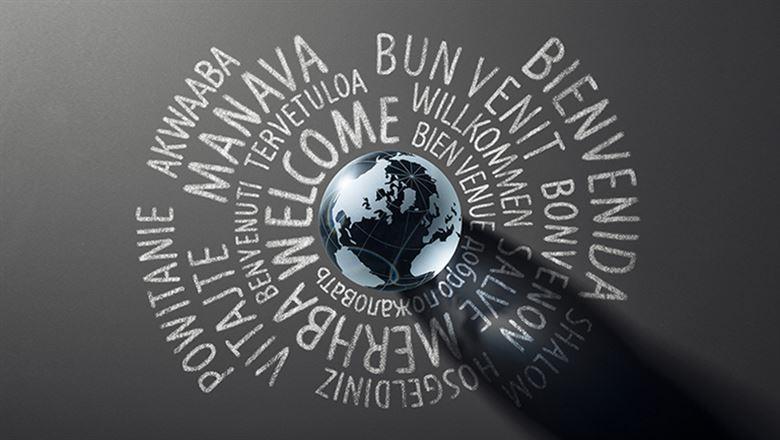Elissa Myers, CAE
Elissa Myers, IOM, CAE, is executive director of the Academy for Eating Disorders in Reston, Virginia.

To connect with more of its members around the world, the Academy for Eating Disorders got serious about translation. From conferences to scientific articles to web content, AED's investment in multilingual communication is paying dividends in member engagement.
English isn't the world's most common language. In fact, it comes third after Chinese and Spanish. But until last year, the Academy for Eating Disorders—a global professional association with members in 40 countries and 31 chapters, partners, and affiliates around the world—communicated predominantly in English. Although English is generally considered the universal language of the scientific community, including AED, we realized that language can be a barrier to membership involvement.
If we wanted AED to become truly global, we would need to communicate to our members in multiple languages. Here's how we did it.
We decided to make our first full foray into translation at our 2016 Conference in San Francisco. To get started, we would provide content in Spanish as well as English. To do this, we sought bids from three well-regarded translation companies and ended up choosing the one with the most professional and creative bid; this firm was also the least expensive at $15,000. The entire process took about six months, from querying colleagues with translating experience to lining up volunteer interpreters for the scientific content.
Our experience with Spanish translation at our conference was positive. Our Spanish-speaking attendance tripled, and those who came to the conference reported high satisfaction.
Before the conference, we had the firm translate our promotions, communication materials, and applications into Spanish, and we posted the Spanish and English versions side by side on our conference website. During the conference, we offered simultaneous Spanish translation of our general sessions, as well as one workshop in each time block. We also invited an Argentinian speaker who delivered his general session address in Spanish. All delegates were offered headsets, through which the translator's interpreted comments were streamed—English to Spanish, or for the one session, Spanish to English.
To keep track of nearly 1,500 headsets, we printed perforated tickets, numbering and printing them with the name of each delegate on both halves of the ticket. Delegates traded one ticket for a headset, and then redeemed their ticket after they were finished. It turned out to be a quick and efficient way to keep track of the devices, which can be a big expense if lost or unreturned.
The conference was largely a success, but we did make some mistakes. We had massive screens at the front of the room to display speakers' PowerPoint presentations. Those on the right side of the room were in Spanish and those on the left were in English, but we forgot to relay this information to attendees as they entered the room. Consequently, many sat on the wrong side of the room.
Still, our experience with Spanish translation was positive. Our Spanish-speaking attendance tripled, and those who came to the conference were effusive in their enthusiasm.
In June of 2016 I received an invitation to deliver the keynote presentation at a meeting of our largest chapter, the Hispanic Latin American AED. I wish that I spoke Spanish—I'm ashamed that I don't—but I was determined to make the effort to deliver my speech in the language of the conference. My granddaughter Rosie is fluent, and she helped me translate my remarks.
We created a phonetic version, and Rosie taught me some important principles, such as the silent H, to help with my pronunciation. During the presentation on November 8, 2016, I heard some giggles, but afterward the expression of appreciation was overwhelming. I've never been prouder, and I wanted to make the point that translation is hard, but it's important to try.
At this meeting, I was among a tiny minority of individuals who wanted to understand the speakers but didn't speak the language. It was a vivid and personal lesson in the importance of making AED accessible to all by tearing down language roadblocks.
AED has a number of other initiatives to improve our communication with non-English-speaking members. For instance, we translated our Medical Care Standards Guide into a half-dozen languages, including Italian and Chinese, with more translations in the works. We also regularly host webinars to provide year-round educational content, some of which are offered in Spanish.
For scientific articles and information, we use a double-blind technique to ensure accuracy. Translator A translates a document from English into his or her native language, and then translator B provides a back-translation into English. Together they review inconsistencies and agree on a final version, which is then submitted for publication. Other materials, such as promotional literature and descriptive reports, require a less formal procedure with just one translator.
Because there is so much important work to be done, we've created a "translation board" comprising members from around the world. Their primary objective is to facilitate the translation of AED materials from English into other languages. The board serves as a resource to other AED entities that develop content and have identified a need for translation.
We also created a database of AED members who have volunteered to translate AED materials. We want to grow this database over time by increasing both the number of languages and translators available.
And we've only just begun. Technology is rapidly providing interim solutions, which, while imperfect, are building some bridges. I believe that by making this effort, we are significantly boosting the interest and engagement of our members around the world.